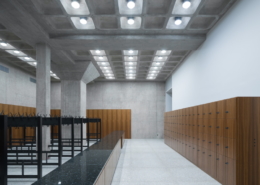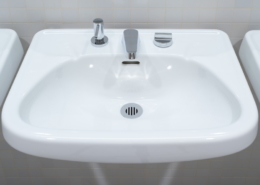New National Gallery in Berlin
Berlin 23 September 1965. The foundation is laid for the New National Gallery. 76-year-old Ludwig Mies van der Rohe had been given the task of building the New National Gallery three years earlier. As one of the most important architects of the modern age, Mies again stayed true to his motto of “less is more” in the construction of this building. Glass and steel. Constructive logic and spatial freedom. Simple but not simplistic. These are the attributes we associate with Mies van der Rohe and which are reflected in the last building he ever planned.
In 2012, David Chipperfield Architects Berlin were awarded the contract to renovate the New National Gallery, and looked to Dornbracht premium-brand fittings for the interiors. Now one of its most important landmarks is close to returning to the cultural sector.
As a museum for twentieth-century art, the New National Gallery embodies Mies’ basic principle of a universal space, and is regarded as an icon of modern architecture. The glass and steel structure is mounted on a granite terrace that is 105 x 110 metres in size. The rectangular roof is supported by eight steel pillars. The glass walls that make up the transparent façade are each set back by 7.2 metres. Thanks to its steel stanchions, the building does not need any additional supporting walls, so you are left with a versatile floorspace that can be put to a wide variety of uses.
In 2012, David Chipperfield Architects Berlin were tasked with renovating the building. To stay faithful to Mies’ approach, they went back to his minimalism for the interiors. The listed landmark was painstakingly dismantled into thousands of individual parts without damaging the visual integrity of the monument and with the aim of retaining as much of the historic substance of the building as possible.
Mies van der Rohe’s architectural approach was also followed in the interiors, and its reduced forms and minimalist principles formed the basis of the modernisation work. David Chipperfield Architects Berlin also recognised clarity and timeless design in design partner Dornbracht, and looked to the premium brand when choosing fittings for the facilities. Form reduction and concentration on top quality and longevity have always been part of the design DNA at Dornbracht. This design language is reflected in the iconic products Dornbracht has produced over the years. Products such as “Tara”, “MEM” or “Vaia” reflect this development process. Based on the traditional “widespreads” (the classic three-hole basin mixer) of the Anglo-American market, the team of architects opted to use the Dornbracht Selv series. Flat in shape and low over the basin, this fitting blends harmoniously into the architecture of the flat and wide structure of the New National Gallery building.
On 29 April 2021, the re-opening of the New National Gallery will be marked by a symbolic key handover ceremony. The first exhibition, with works by American artist Alexander Calder (1898-1976), is planned for August 2021.
| Branch | Museum |
| Interior Architect | David Chipperfield Architects |
| Photographer | © 2021, BBR / Photo: Marcus Ebener |
| Opening | 2021 |
























